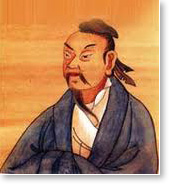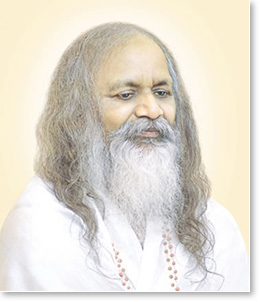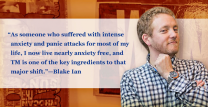Zhuangzi
369–286 B.C. • CHINA
Zhuangzi, also known as Chuang Tzu, is esteemed alongside Laozi as one of the founders of Daoism in China. His writings also influenced the growth of Chinese Buddhism. Ancient though his writings are, Zhuangzi often refers to the “sages of old,” placing the source of this knowledge in an even more distant antiquity.
Almost nothing is known of his personal life; he may have been a minor government official. But his writings (known as the Zhuangzi) show him to be a brilliant, original thinker, concerned with how to live in a world of suffering and absurdity. After more than 2,000 years, his writings remain remarkably contemporary — in the issues he confronts, the solutions he proposes, and the humor he employs.
 In contrast to other schools that proposed political changes to improve individual and social life, Zhuangzi proposed a different solution: bring yourself into harmony with the Dao, the Way, nature’s intelligence, and the world will change automatically.
In contrast to other schools that proposed political changes to improve individual and social life, Zhuangzi proposed a different solution: bring yourself into harmony with the Dao, the Way, nature’s intelligence, and the world will change automatically.
And for this, a certain kind of experience is necessary. Here is how he describes it:
Why don’t you try wandering with me to the Palace of Not-Even-Anything — identity and concord will be the basis of our discussions and they will never come to an end, never reach exhaustion. Why not join with me in inaction, in tranquil quietude, in hushed purity, in harmony and leisure? Already my will is vacant and blank. I go nowhere and don’t know how far I’ve gotten. I go and come and don’t know where to stop. I’ve already been there and back, and I don’t know when the journey is done. I ramble and relax in unbordered vastness; Great Knowledge enters in, and I don’t know where it will ever end. [1]

Zhuangzi dreaming of a butterfly (or a butterfly dreaming of Zhuangzi)
Zhuangzi goes on to tell us what this experience is like. It brings one to “inaction,” “tranquil quietude,” “hushed purity,” “harmony.” In this state one’s mind encompasses “unbordered vastness” — consciousness in its pure, unbounded status. It also brings “Great Knowledge” — not knowledge of any particular thing but what Maharishi calls pure knowledge, pure knowingness — the experience of consciousness having settled inward and becoming awake to itself alone.
Zhungzi elaborates on this simple, silent state as follows:
The repose of the Sage is not what the world calls repose. His repose is the result of his mental attitude. All creation could not disturb his equilibrium: hence his repose. When water is still, it is like a mirror, reflecting the beard and the eyebrows. It gives the accuracy of the water-level, and the philosopher makes it his model. And if water thus derives lucidity from stillness, how much more the faculties of the mind! The mind of the Sage, being in repose, becomes the mirror of the universe, the speculum [reflector] of all creation. [2]
When your mind is truly “in repose,” Zhuangzi tells us, it reflects the entirety of the universe. What can this mean? Pure consciousness, Maharishi asserts, is identical with the unified field of natural law — the source of thought deep within each of us is identical with the source of all the laws of nature deep within every point in the universe.
This, for Zhuangzi, is how we can bring our lives into harmony with nature, with natural law — experience the Dao (pure consciousness) deep within us. What we can know or say about the Dao, Zhuangzi taught, is not the Dao itself — but it can be experienced.

Maharishi Mahesh Yogi
peer-reviewed studies
This inner treasury of life has been given different names in different times and places. But the reality is the same. It is the simplest form of human awareness. And it is available to everyone.
REFERENCES
[1] The Complete Writings of Chuang Tzu, trans. Burton Watson (New York: Columbia University Press, 1968), 241.
[2] Musings of a Chinese Mystic: Selections from the Philosophy of Chuang Tzu, trans. Lionel Giles (London: John Murray, 1911), 90.
__________________________________________________
 Dr. Craig Pearson is Executive Vice-President of Maharishi University of Management in Fairfield, Iowa. He has served the University in a variety of roles over the past 33 years, including Dean of Faculty, Dean of Students, Director of Maharishi University of Management Press, Director of Freshman Composition, and Professor of Professional Writing.
Dr. Craig Pearson is Executive Vice-President of Maharishi University of Management in Fairfield, Iowa. He has served the University in a variety of roles over the past 33 years, including Dean of Faculty, Dean of Students, Director of Maharishi University of Management Press, Director of Freshman Composition, and Professor of Professional Writing.
He holds a PhD in Maharishi Vedic Science from MUM and is the author of two books on the development of full human potential, The Complete Book of Yogic Flying and The Supreme Awakening: Developing the Infinite Potential Within (forthcoming). He is also a member of the Board of Directors of Maharishi School of the Age of Enlightenment.
Other posts by Craig Pearson:
“The kingdom of God is within you”
Henry David Thoreau – “We become like a still lake of purest crystal”
Alfred, Lord Tennyson – “A state of transcendent wonder”
Helen Keller – “I feel the flame of eternity in my soul”
Laozi – “His mind becomes as vast and immeasurable as the night sky”
Walt Whitman – “The luminousness of real vision”
Ralph Waldo Emerson – “Within man is the soul of the whole; the wise silence; the universal beauty”



